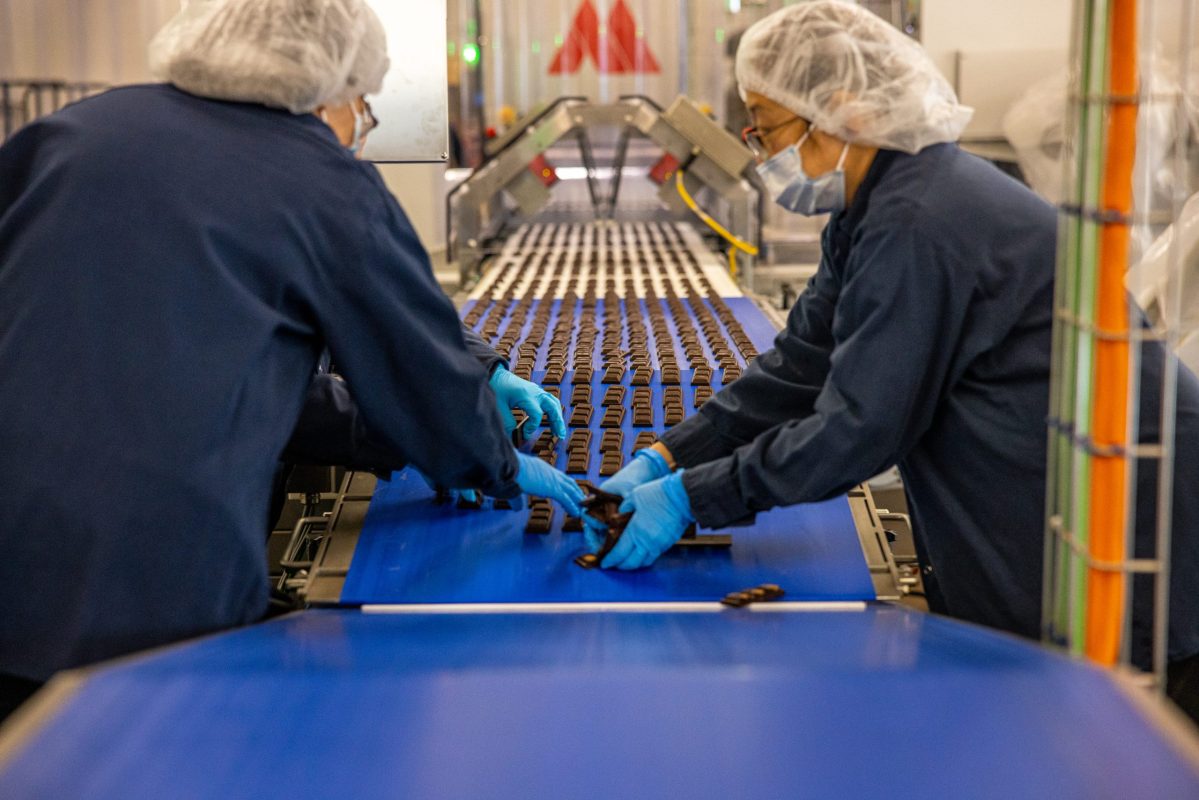TCHO Chocolate
3100 San Pablo Ave. (near Ashby Avenue), Berkeley
Factory tour tickets (which include a tasting) are available online for a $15 deposit
After a pandemic-prompted two year hiatus, Berkeley’s TCHO chocolate factory has reopened for tours, a look behind the candy curtain — and a chance to taste some of its most desirable offerings. The chocolate factory tours, open to parties of 1-15 people, with a $15 deposit per person, would be fun to do with a group of friends. You can decide “who wears it better” when you put on your protective paper hats.
After participants wash up and don hats and gowns, the tour begins with a brief but informative history lesson from chief chocolate maker Brad Kintzer. Before you get to see the rooms where it happens, you will learn about how the flower becomes the fruit and the fruit gets fermented, dried and roasted, followed by the rest of the process: cracking, winnowing, melange-ing (grinding), tempering and finally, wrapping — when it is finally transformed from a bitter bean to a melt-in-your mouth treat.
This transformative process has been around for a long time: as we learn in the pre-tour information session, the first evidence of human use of cocoa dates back 5300 years. (Note: in earlier research, I learned that in Central America, products of the cacao bean were only consumed by royalty or members of the priesthood. In the Aztec culture, cacao was used as currency, so only the wealthy could afford to “drink money.” The crème de la crème — froth — was created by pouring a spiced liquid chocolate mixture from one vessel to another. Legend has it that Montezuma drank about fifty cups of foam a day. We can only imagine the effect this must have had on him.)
One fascinating part of the pre-tour talk had to do with sensory training and the creation of a language used to discuss flavor as there wasn’t always a shared language to calibrate taste based on aroma, acidity, bitterness, astringency and other contributing factors. We saw an example of the rubric for how flavor can be categorized: sweet, nutty, dried fruit, fresh fruit, spices, etc.
Much like wine, the taste of chocolate is influenced by “terroir;” and although 70% of cacao beans come from West Africa, taste will differ based on the origin and parts of the process of going from bean to bar. (Most cacao farmers, Kintzer said, have never even tasted chocolate made from their own beans.)
Other factors can affect the flavor as well: if the fermentation process goes on too long, the chocolate tastes bad; if there is smoke in the air, it can get sucked into the cocoa, creating a flavor reminiscent of smoked ham.
If you go on the TCHO tour expecting to see a Willy Wonka-esque collection of vats and tanks and machinery that shoots chocolate into molds on a grand scale, you will not be disappointed. You’ll get a long look at the melting tanks, full of unsweetened chocolate that gets pumped for 24 hours to refine it until smooth. The tempering process manipulates the structure of chocolate from a liquid to a solid with a nice shine and the consistency to melt in your mouth. My favorite part of the tour was watching the chocolate getting poured into molds: the track moves at a pace no Lucy-like attendant could keep up with, as the chocolate is measured precisely into the little squares as they go marching by.
A tour of a chocolate factory would not be complete without a tasting session, at which you can savor a variety of offerings while exploring the ways in which origin and additional flavors create unique flavor profiles. And, let’s face it, you get to try half a dozen pieces of chocolate: what’s not to like?
A brief rundown on the ones we tried:
Holy Fudge, a single-origin chocolate from Ghana; Born Fruity, with its citrus and dried fruit-forward taste from start to finish; and Dark Duo, with a cocoa shell from Ghana and a filling from Peru. The sample of Oat My Gawd (made with oat milk) had what I have to describe as “oat notes,” which is not a bad thing if you find comfort and delight in a warm oatmeal cookie. In addition to the oat flavor, I found it to be tangy and salty. Reactions to the oat flavor may vary, but it’s good to keep an open mind around chocolate. Toffee Time is a perfect blend of toffee and chocolate, a classic combination of flavors.
There were also couple of new seasonal varieties: Pumpkin Up, made with plant-based white chocolate, cashew butter, oat milk, pumpkin and bits of spicy cookie; and Karl the Nog, made with egg nog, oat milk and white chocolate with flavors of rum and nutmeg.
TCHO makes chocolate that is plant-based, organic and fair trade. They have also lessened the sugar content without, they said, sacrificing any of the flavor. With some input from consumers, TCHO has also redesigned its packaging, so when you open one of those colorful boxes, the little squares of chocolate are easy to break off and enjoy.
Unlike the oft quoted (but frequently misappropriated) observation by poet John Godfrey Saxe that “Laws, like sausages, cease to inspire respect in proportion as we know how they are made,” seeing how chocolate is made only increases respect for the care taken during the entire bean to bar process at TCHO. After taking the tour, its chocolates tastes all the sweeter.

